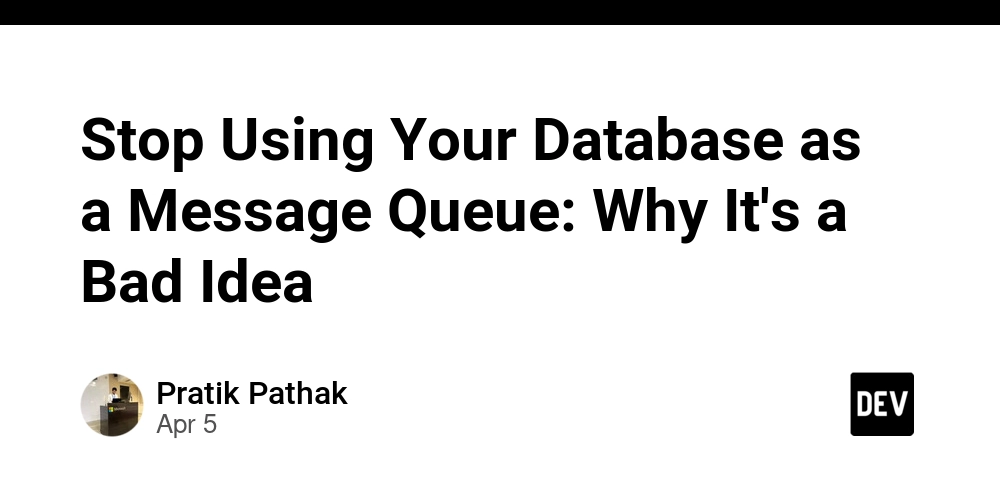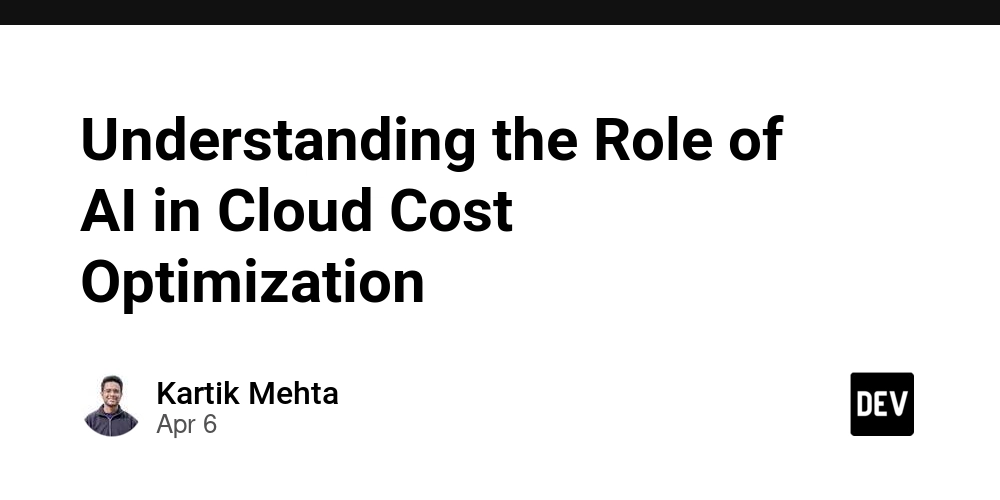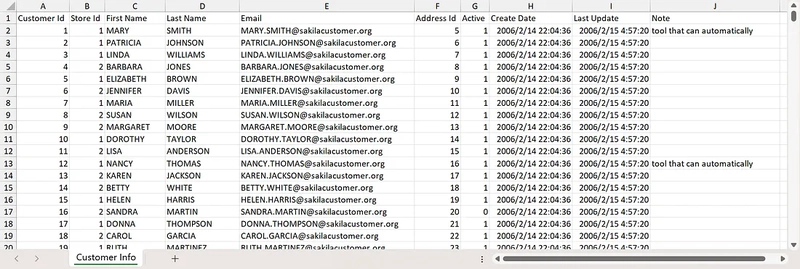Stop Using Your Database as a Message Queue: Why It's a Bad Idea
Are you using your database to handle communication between servers? It might appear easy, but it's often a risky choice. What starts as a quick fix can quickly become a big problem for performance and growth. This method, called using a database as a message queue, is a bad habit that can cause major issues as your system gets bigger. In this article, we'll look closely at the problems with this approach. We'll see why it hurts performance, makes scaling difficult, and harms your system's design. We'll explore the specific issues it creates, like too much database load and complicated data handling. Also, we'll see why dedicated message queues are a much better way to build strong and scalable systems. Find out why moving away from using a database for messages can protect your system in the future. Learn how it improves user experience and makes development easier. The Illusion of Simplicity: How Databases Become Accidental Message Queues Let's consider how databases are often used as message queues. It seems appealing at first, and here's how it usually begins. Imagine servers that need to talk to each other, and they use the database to do it. The "Simple" Implementation: Inserting Messages into the Database Think about one server needing to send a message to another. It puts the message into the database for the other server to find. It's like writing a note and leaving it in a public place. This involves using a database command to insert the message. Polling for Updates: The Inherent Inefficiency Servers have to constantly check the database for new messages. They ask, "Is there anything for me?" all the time. This is known as polling, and it uses a lot of resources. It can really slow things down. The Performance Pitfalls: Why Polling Kills Your Database This section will focus on the performance issues of using a database as a message queue. We'll explore the problems of frequent polling and the limits of database optimization. The Frequent Polling Problem: Overloading the Database with Read Operations Frequent polling means the database is constantly doing read operations. It's like asking the same question over and over. This can overload the database and make everything slower. For example, if many servers poll every second, the database can get overwhelmed. The Long Interval Problem: Delayed Messages and Poor User Experience What if servers don't check the database very often? The messages might get delayed. If a mobile user expects a message quickly, waiting a long time is bad. So, slower polling leads to a worse experience. Read-Write Conflict: Databases Aren't Optimized for Both Databases are usually made to be good at either reading or writing data, but not both at the same time. If you're constantly reading and writing messages, it causes problems. Imagine a shop trying to stock shelves and serve customers with the same person. It's not very efficient. The CRUD model is how we study how much time each of these operations take. Databases are rarely designed such that read and write operations are both fast. The Data Management Nightmare: Storage, Deletion, and Complexity This section will focus on the challenges of managing message data inside a database. We'll discuss storage, how to delete old messages, and the complexity of managing message lifecycles. Storage Bloat: The Ever-Growing Message Log Message data can quickly fill up the database. It's like a pile of papers growing taller and taller. This can cause storage issues and slow down the database. If servers send many messages to each other, the database will soon be full. The Deletion Dilemma: Manual Scripts and Cron Jobs Deleting or archiving old messages is difficult. You might need special scripts or scheduled tasks (cron jobs). These add complexity and can cause errors. It's like having to manually clean up that pile of papers every day. Scalability Showstoppers: Why Databases Can't Handle the Load This section will focus on the limits of using a database as a message queue when your system grows. We'll explain why this method fails as the system gets bigger. Also, we'll talk about the problems with adding more databases. The Bottleneck Effect: One Database, Many Servers As you add more servers, the database becomes a central bottleneck. It's like a single lane road trying to handle traffic from many highways. Too many servers reading and writing messages can overwhelm the database. The Sharding Struggle: Complicating Communication Between Servers What if you split the database into smaller parts (sharding) to improve scaling? It makes routing messages between servers more complex. How does server 4 talk to server 2? It becomes a difficult puzzle. The Message Queue Solution: A Superior Alternative This section introduces message queues as the right solution. We'

Are you using your database to handle communication between servers? It might appear easy, but it's often a risky choice. What starts as a quick fix can quickly become a big problem for performance and growth. This method, called using a database as a message queue, is a bad habit that can cause major issues as your system gets bigger.
In this article, we'll look closely at the problems with this approach. We'll see why it hurts performance, makes scaling difficult, and harms your system's design. We'll explore the specific issues it creates, like too much database load and complicated data handling. Also, we'll see why dedicated message queues are a much better way to build strong and scalable systems.
Find out why moving away from using a database for messages can protect your system in the future. Learn how it improves user experience and makes development easier.
The Illusion of Simplicity: How Databases Become Accidental Message Queues
Let's consider how databases are often used as message queues. It seems appealing at first, and here's how it usually begins. Imagine servers that need to talk to each other, and they use the database to do it.
The "Simple" Implementation: Inserting Messages into the Database
Think about one server needing to send a message to another. It puts the message into the database for the other server to find. It's like writing a note and leaving it in a public place. This involves using a database command to insert the message.
Polling for Updates: The Inherent Inefficiency
Servers have to constantly check the database for new messages. They ask, "Is there anything for me?" all the time. This is known as polling, and it uses a lot of resources. It can really slow things down.
The Performance Pitfalls: Why Polling Kills Your Database
This section will focus on the performance issues of using a database as a message queue. We'll explore the problems of frequent polling and the limits of database optimization.
The Frequent Polling Problem: Overloading the Database with Read Operations
Frequent polling means the database is constantly doing read operations. It's like asking the same question over and over. This can overload the database and make everything slower. For example, if many servers poll every second, the database can get overwhelmed.
The Long Interval Problem: Delayed Messages and Poor User Experience
What if servers don't check the database very often? The messages might get delayed. If a mobile user expects a message quickly, waiting a long time is bad. So, slower polling leads to a worse experience.
Read-Write Conflict: Databases Aren't Optimized for Both
Databases are usually made to be good at either reading or writing data, but not both at the same time. If you're constantly reading and writing messages, it causes problems. Imagine a shop trying to stock shelves and serve customers with the same person. It's not very efficient. The CRUD model is how we study how much time each of these operations take. Databases are rarely designed such that read and write operations are both fast.
The Data Management Nightmare: Storage, Deletion, and Complexity
This section will focus on the challenges of managing message data inside a database. We'll discuss storage, how to delete old messages, and the complexity of managing message lifecycles.
Storage Bloat: The Ever-Growing Message Log
Message data can quickly fill up the database. It's like a pile of papers growing taller and taller. This can cause storage issues and slow down the database. If servers send many messages to each other, the database will soon be full.
The Deletion Dilemma: Manual Scripts and Cron Jobs
Deleting or archiving old messages is difficult. You might need special scripts or scheduled tasks (cron jobs). These add complexity and can cause errors. It's like having to manually clean up that pile of papers every day.
Scalability Showstoppers: Why Databases Can't Handle the Load
This section will focus on the limits of using a database as a message queue when your system grows. We'll explain why this method fails as the system gets bigger. Also, we'll talk about the problems with adding more databases.
The Bottleneck Effect: One Database, Many Servers
As you add more servers, the database becomes a central bottleneck. It's like a single lane road trying to handle traffic from many highways. Too many servers reading and writing messages can overwhelm the database.
The Sharding Struggle: Complicating Communication Between Servers
What if you split the database into smaller parts (sharding) to improve scaling? It makes routing messages between servers more complex. How does server 4 talk to server 2? It becomes a difficult puzzle.
The Message Queue Solution: A Superior Alternative
This section introduces message queues as the right solution. We'll explain their benefits and how they fix the problems of using databases as message queues.
Push vs. Poll: The Efficiency of Message Queues
Message queues push messages to the servers that need them. It's like a delivery service bringing packages directly to your door. This gets rid of constant polling and reduces the load on the database.
Optimized for Messaging: The Strengths of Specialized Systems
Message queues are designed specifically for handling messages. They offer features like guaranteed delivery and message prioritization. It's like using a tool designed for a specific job.
Scalability Built-In: Adding Capacity as Needed
Message queues can be easily scaled by adding more queues as needed. This provides a flexible solution for growing systems. You can throw more money at the problem to scale.
When Databases Might Suffice: Weighing the Trade-offs
This section discusses the few situations where using a database as a message queue might be okay. We'll cover small systems, low message volume, and resource limits.
Small Scale, Low Volume: When the Load is Manageable
In small systems with few messaging needs, the database might be good enough. If there are only a few servers and messages, the load might be manageable.
Resource Constraints: When Complexity is Too High
Sometimes, setting up a message queue might be too much work for the benefits it provides. If the project is short-lived, the overhead might not be worth it. Introducing a new concept requires training and time.
Interview Considerations: Asking the Right Questions
If you're asked about this in an interview, ask about the scale of the system. If they're asking about scaling to handle a lot of users, using a database is an anti-pattern.
Conclusion
Using a database as a message queue can seem like a simple solution, but it often leads to performance and scaling issues. Message queues offer a better way to handle inter-server communication, especially for large systems. Consider the trade-offs and choose the right tool for the job.











































































































































































![[The AI Show Episode 142]: ChatGPT’s New Image Generator, Studio Ghibli Craze and Backlash, Gemini 2.5, OpenAI Academy, 4o Updates, Vibe Marketing & xAI Acquires X](https://www.marketingaiinstitute.com/hubfs/ep%20142%20cover.png)



























































































































![[FREE EBOOKS] The Kubernetes Bible, The Ultimate Linux Shell Scripting Guide & Four More Best Selling Titles](https://www.javacodegeeks.com/wp-content/uploads/2012/12/jcg-logo.jpg)



![From drop-out to software architect with Jason Lengstorf [Podcast #167]](https://cdn.hashnode.com/res/hashnode/image/upload/v1743796461357/f3d19cd7-e6f5-4d7c-8bfc-eb974bc8da68.png?#)






































































































.png?#)




.jpg?#)































_Christophe_Coat_Alamy.jpg?#)









































































































![Rapidus in Talks With Apple as It Accelerates Toward 2nm Chip Production [Report]](https://www.iclarified.com/images/news/96937/96937/96937-640.jpg)








































































































































